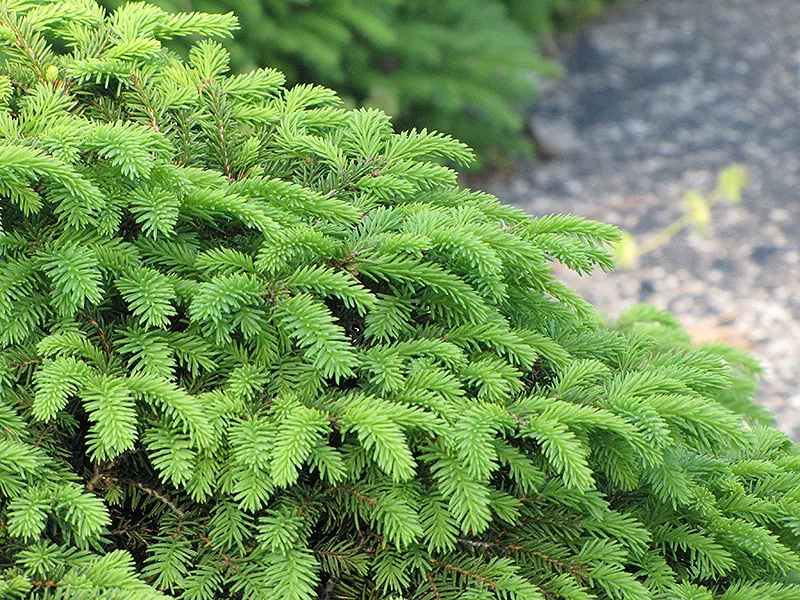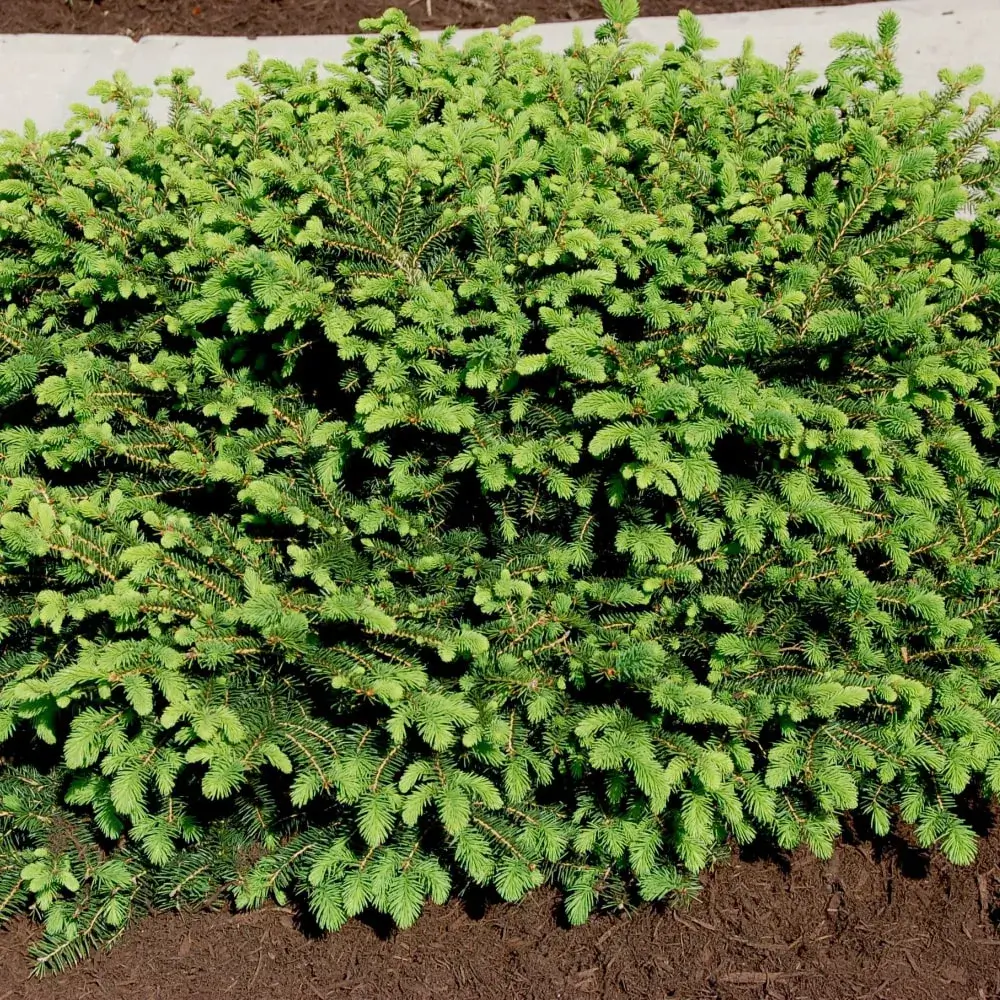Family: Spruce
Type: Shrub
Other Common Name: Norwegian Spruce

Bird’s Nest Spruce, scientifically known as Picea abies ‘Nidiformis’, is a charming dwarf conifer renowned for its unique, nest-like shape. This evergreen shrub features dense, flat-topped foliage that resembles a bird’s nest, hence its name. It is an ideal choice for gardeners looking for low-maintenance and year-round greenery.
Growing slowly to a height of 3-4 feet and a similar spread, Bird’s Nest Spruce is perfect for small spaces. Its compact size makes it a great addition to any landscape, whether in a small city garden or a large suburban yard. The shrub’s dark green needles remain vibrant throughout the year, adding a constant splash of color.
Bird’s Nest Spruce is known for its hardiness and ability to thrive in a variety of conditions. It prefers full sun to partial shade and well-drained soil, making it a versatile choice for different garden settings.
Hardiness Zone: 3a-3a
Deer Resistant: Yes
Pet Friendly: Yes
Moisture Preference: Average to moist
Sun Needs: Full sun to partial shade
Growth Rate: Slow
Average Height (feet): 4
Average Spread (feet): 5
Average Life Span (years): 50
Form: Round
Foliage Color: Green
Foliage Shape: Needle
Bark Color: Gray
Bark Texture: Smooth
Bird’s Nest Spruce can be used as a focal point in small garden beds or borders. Its distinctive shape and evergreen foliage provide year-round interest and a unique texture to the landscape. Plant it as a standalone specimen or in a group for a more impactful display.
This shrub is excellent for rock gardens or as a foundation planting. Its low-growing, spreading habit makes it a good choice for ground cover, and it pairs well with both perennials and other shrubs. Use Bird’s Nest Spruce in mixed beds for a contrast in height and texture.
Bird’s Nest Spruce is also suitable for container gardening. Its compact size and slow growth rate make it an ideal choice for pots or planters, either on patios, balconies, or flanking entryways.

In Japanese garden designs, Bird's Nest Spruce adds a sense of tranquility and natural beauty. Its neat growth habit and evergreen nature fit well with the Zen-like simplicity of Japanese gardens.
For alpine and rock gardens, this spruce is a perfect fit. Its tolerance for well-drained soil and its compact form blend seamlessly with the rugged terrain of rock gardens.
In formal garden settings, Bird's Nest Spruce offers structure and year-round color. Its symmetrical shape and consistent foliage make it a great choice for creating a formal, manicured look.
Use Bird’s Nest Spruce as a natural border along walkways or garden paths. Its compact form creates a neat, unobtrusive edge while adding greenery. Planting it in a row can create a low, formal hedge.
Select our pre-made garden layouts to create a landscape that’s uniquely yours. Simple, smart, and customizable!
In spring, Bird's Nest Spruce maintains its lush green appearance. Its dense foliage begins to fill in, further defining its nest-like shape.
During summer, the shrub remains a steadfast, evergreen presence in the garden. It provides a cool, calming green backdrop to summer blooms.
In fall, while other plants begin to fade, Bird's Nest Spruce continues to hold its vibrant green color. It stands out in the autumn landscape as other foliage changes color.
Winter showcases the strength of Bird's Nest Spruce. Its evergreen needles persist through the cold, providing color and structure in the otherwise barren winter garden.
Bird’s Nest Spruce thrives in areas with full sun to partial shade. It’s well-suited for small garden spaces, rock gardens, and as part of mixed borders where its unique shape can be appreciated.
This plant prefers full sun but can tolerate partial shade. Full sun promotes the densest growth and maintains the vibrant green color of the needles.
Bird's Nest Spruce does well in well-drained soil. It can adapt to various soil types, including sandy, loamy, or clay soils, as long as they are not waterlogged.
Space these shrubs about 3-4 feet apart. This spacing allows enough room for their natural, spreading growth while ensuring they don't overcrowd other plants.
The best time to plant Bird’s Nest Spruce is in the spring or early fall. This timing allows the plant to establish its roots before the stress of extreme summer heat or winter cold.
Plant at the same depth it was in its container. Loosen the soil around the planting hole to encourage root expansion. Water thoroughly after planting to settle the soil around the roots.
Water regularly during the first growing season to establish a deep, extensive root system. Once established, Bird’s Nest Spruce is relatively drought-tolerant but may benefit from occasional watering during prolonged dry spells.
Fertilize in early spring with a balanced, slow-release fertilizer to promote healthy growth. Avoid over-fertilizing, as this can lead to excessive growth at the expense of the plant’s form.
Pruning is generally not necessary for Bird’s Nest Spruce, as it maintains its shape naturally. If needed, prune in late winter or early spring to remove any dead or damaged branches.
In spring, check for any winter damage and prune as needed. Apply fertilizer to support new growth.
During summer, ensure the plant gets enough water, especially during hot, dry periods.
In fall, no specific care is needed as the plant prepares for dormancy.
Bird's Nest Spruce requires minimal care in winter. Its compact and robust nature allows it to withstand cold temperatures and snow.
Bird’s Nest Spruce has a slow to moderate growth rate, making it an ideal plant for those looking for low-maintenance landscaping options.
Yes, Bird’s Nest Spruce is generally considered to be deer resistant. Its dense foliage and needle-like leaves are not favored by deer.
Yes, due to its compact size and slow growth, Bird’s Nest Spruce can be successfully grown in containers. This makes it a versatile choice for patios, terraces, or areas with limited space.
Sign up below to get exclusive deals, discounts, and new plant collections—delivered straight to your inbox! Plus, stay inspired with the latest gardening tips, landscaping trends, and DIY garden ideas. Start growing with us today!
A big thank you for subscribing to the PBN Design newsletter.
We're thrilled to have you join our community. Get ready for exciting updates, insightful content, and more delivered straight to your inbox.
Stay tuned!
Go backA big thank you for subscribing to the PBN Design newsletter.
We're thrilled to have you join our community. Get ready for exciting updates, insightful content, and more delivered straight to your inbox.
Stay tuned!
Go back